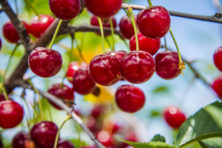Early Snow Burdens Corn Harvest
- Share
- Tweet
- Pin
- Share
Many who spent the summer in Door County know that it was more wet and mild compared to the usual pristine conditions. Matched with the early November snow, this high precipitation has left county farmers with the difficult task of dealing with high-moisture corn.
The result? “You will see a lot of corn standing in the field this winter,” said Joe Haberli of Haberli Farms in Egg Harbor.
High-moisture corn occurs when the kernels reach a moisture level above 15 percent. For the crop that Haberli is farming throughout Door County, moisture levels sit between 30-40 percent. High moisture poses the issue of molding and rotting during storage. The stored crops can also internally combust due to bacteria growth in the moist environment. “There are no benefits [with moist corn]. I mean, there’s a little you can use for the cattle but not much,” said Haberli.
Haberli does not expect to get the majority of his crop out, saying he will be happy to get 1,000 acres from more than 5,000 acres that he farms annually. Last winter, he faced a similar problem of high moisture levels, but found that leaving the corn through the winter did not hurt as much as he expected.
By leaving a majority of the crop in the ground through the winter, the reduced supply drove prices of corn up. The increased price of corn made up for losing the corn that was left in the ground. While it is impossible to predict increased corn prices, Haberli hopes the same will happen this winter as he leaves some of his corn in the ground. The cold winter air can freeze the corn and allow for it to dry out in the coldest months.
The only way to deal with high-moisture corn besides letting it sit in the field is to dry it out before long-term storage. A common practice in drying out corn consists of using propane gas to run hot air through the corn. However, the cost of running propane gas through thousands of acres of harvested corn can be prohibitive.
Following a year with a very high yield of corn, the large supply has caused prices to drop. Throughout Wisconsin, prices for corn are sitting around $3.50 per bushel. The cost of drying corn is consistently at about 50 cents per bushel. Losing such a large percentage per bushel makes the process too costly.
Haberli hopes to farm enough land to feed his cattle and get by until the rest of the corn can come out. Farming the rest of the corn will be dependent on a dry winter, leaving Haberli prepared to farm through the winter months. If the winter proves wet and snowy, farmers may be left to abandon some of the crop and hope for better conditions next year.



